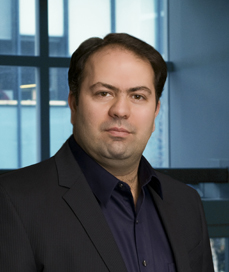
Abstract
Integrated electronic-photonic co-design can profoundly impact both fields resulting in advances in several areas such as energy efficient communication, signal processing, imaging, and sensing. Examples of integrated electronic-photonic co-design may be categorized into two groups: (a) electronic assisted photonics, where integrated analog, RF, mm-wave, and THz circuits are employed to improve the performance of photonic systems, and (b) photonic assisted electronics, where photonic systems and devices are used to improve the performance of integrated RF, mm-wave, and THz systems. In this talk, examples of electronic-photonic co-design such as photonic assisted energy efficient near-field imaging, optical synthesis, and low power laser stabilization and linewidth reduction will be presented.
Biography
Firooz Aflatouni received the Ph.D. degree in Electrical Engineering from the University of Southern California, Los Angeles, in 2011. He was a post-doctoral scholar in the Department of Electrical Engineering at the California Institute of Technology before joining the University of Pennsylvania in 2014 where he is Skirkanich Assistant Professor in the Department of Electrical and Systems Engineering. His research interests include electronic-photonic co-design and low power RF and mm-wave integrated circuits. In 1999, he co-founded Pardis Bargh Company where he served as the CTO for five years working on design and manufacturing of inclined-orbit satellite tracking systems. From 2004 to 2006, he was a Design Engineer with MediaWorks Integrated Circuits Inc., Irvine, CA. Firooz received the Young Investigator Program (YIP) Award from the Office of Naval Research in 2019, the NASA Early Stage Innovation Award in 2019, the 2015 IEEE Benjamin Franklin Key Award, 2011 USC Department of Electrical Engineering best Ph.D. thesis award, and 2010 NASA Tech Award for his work on development of a Ka-Band SiGe receiver MMIC for space transponder applications.